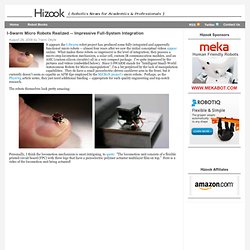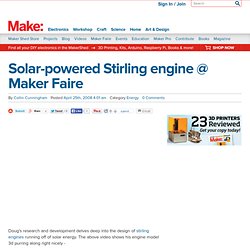

Impressive Full-System Integrat. It appears the I-Swarm robot project has produced some fully-integrated and apparently functional micro robots -- almost four years after we saw the initial conceptual videos appear online.

What makes these robots so impressive is the level of integration; they possess a micro-step locomotion mechanism, a solar cell, custom IR communication modules, and an ASIC (custom silicon circuitry) all in a very compact package. I've quite impressed by the pictures and videos (embedded below). Solar Cell Tutorial. Solar Cell Tutorial Here are two solar cells as purchased on Ebay.

Those tape-on leads dont lend themselves to being easily used by hobbyists, you can't solder to them and mechanical clamping is unreliable. Remove the leads and gently scrape them with an exacto. Get a Permatex window defogger repair kit, you will be using the condutive paint in the kit. MAKE: Blog: Solar-powered Stirling engine @ Maker Faire. Doug’s research and development delves deep into the design of stirling engines running off of solar energy.

The above video shows his engine model 3d purring along right nicely - I’m in the process of performance testing the engine to see how closely its power output agree with my simulation. There are many sinks for losing power including: bearing friction on the rotating shaft, sliding friction on the piston and displacer shaft, compression leakage around the piston and displacer shaft seal, air friction on the air moving around the displacer, and air friction on the spinning flywheel.
My basic and inexpensive instrumentation for this operation includes a stopwatch and a bicycle speedometer used as a tachometer. Using engineering computations and these two instruments I can derive the friction based on how long it takes the unpowered engine to spin down.